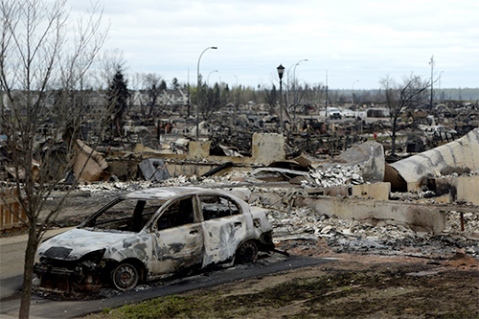James
Hansen on Greenland Ice and Canada’s Fires
10
May, 2016
The town of Fort McMurray, some four hundred miles north of Calgary, in Canada, grew up very quickly on both sides of the Athabasca River. During the nineteen-seventies, the population of the town tripled, and since then it has nearly tripled again. All this growth has been fuelled by a single activity: extracting oil from a Florida-sized formation known as the tar sands. When the price of oil was high, there was so much currency coursing through Fort McMurray’s check-cashing joints that the town was dubbed “Fort McMoney.”
Now Fort McMurray is burning. A forest fire that began to the southwest of the town on Sunday has forced the entire population—almost ninety thousand people—to evacuate. On Wednesday, Alberta’s provincial government declared a state of emergency. By yesterday, more than fifteen hundred buildings had been destroyed and the blaze had spread through an area covering more than three hundred square miles. It was burning so hot that that it was easily able to jump major rivers. One Canadian official described the fire as “catastrophic.” Another called it a “multi-headed monster.”
No one knows exactly how the fire began—whether it was started by a lightning strike or by a spark provided by a person—but it’s clear why the blaze, once under way, raged out of control so quickly. Alberta experienced an unusually dry and warm winter. Precipitation was low, about half of the norm, and what snow there was melted early. April was exceptionally mild, with temperatures regularly in the seventies; two days ago, the thermometer hit ninety, which is about thirty degrees higher than the region’s normal May maximum. “You hate to use the cliché, but it really was kind of a perfect storm,” Mike Wotton, a research scientist with the Canadian Forest Service, told the CBC.
Though it’s tough to pin any particular disaster on climate change, in the case of Fort McMurray the link is pretty compelling. In Canada, and also in the United States and much of the rest of the world, higher temperatures have been extending the wildfire season. Last year, wildfires consumed ten million acres in the U.S., which was the largest area of any year on record. All of the top five years occurred in the past decade. In some areas, “we now have year-round fire seasons,” Matt Jolly, a research ecologist for the United States Forest Service, recently told the Times.
“You can say it couldn’t get worse,” Jolly added, but based on its own projections, the forest service expects that it will get worse. According to a Forest Service report published last April, “Climate change has led to fire seasons that are now on average 78 days longer than in 1970.” Over the past three decades, the area destroyed each year by forest fires has doubled, and the service’s scientists project that it’s likely to “double again by midcentury.” A group of scientists who analyzed lake cores from Alaska to obtain a record of forest fires over the past ten thousand years found that, in recent decades, blazes were both unusually frequent and unusually severe. “This extreme combination suggests a transition to a unique regime of unprecedented fire activity,” they concluded.




No comments:
Post a Comment
Note: only a member of this blog may post a comment.